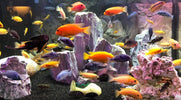
African Cichlids: The Rock Dwellers of the Rift Lakes
, by Majella Gee, 29 min reading time

, by Majella Gee, 29 min reading time
If American cichlids are bold and brash, their African cousins are pure organised chaos — territorial, brilliantly coloured, and completely unapologetic.
They don’t just live in tanks; they take over, rearrange, and run them like underwater empires.
African cichlids are living proof that you don’t need saltwater fish to have a tank bursting with colour — you just need a bit of patience, a lot of rocks, and the ability to accept that they’ll do things their way.
Let’s explore what makes these fish so fascinating — from the lakes they call home to the quirks that make keeping them both challenging and wildly rewarding.

Meet the Africans
African cichlids hail primarily from three Great Rift Valley lakes: Malawi, Tanganyika, and Victoria. Each lake has its own ecosystem, producing species with unique temperaments, colours, and needs.
Common Species Groups
Kribensis (or “Kribs”) are a beginner’s dream. They’re hardy, easy to breed, and can coexist with most community fish — something rare in cichlid land. Their shimmering purples, reds, and golds make them as pretty as any peacock, minus the chaos.
Every lake (and river) produces its own personality.
Malawi’s Mbuna are like little bulldozers on espresso shots. Tanganyika’s residents tend to be more specialised, from shell dwellers to sand sifters. Peacocks? The elegant show ponies of the group. And Kribs — the polite guests who somehow make everyone else look like troublemakers.

Tank Size: Space Is Survival
Cichlids don’t do “cosy.” The more space you give them, the fewer fights you’ll have.
A crowded tank might look pretty at first, but it quickly turns into a turf war.
African cichlids need horizontal swimming room and plenty of rockwork to claim territory.
Use rocks to break up line-of-sight — this reduces aggression dramatically. And remember, what looks “big” to you is still small to a fish that thinks it owns the place.
Water Quality & Chemistry
Here’s where African cichlids stand apart from their American relatives — they love hard, alkaline water.
They come from mineral-rich lakes, so trying to soften the water or chase a neutral pH will just stress them out.
Use crushed coral, aragonite sand, or limestone in your substrate and filters to naturally buffer and maintain the right hardness.
Australian tap water is often perfect for them, especially in coastal regions — but always test before adding fish.
Weekly 20–30% water changes are essential to keep nitrate levels low and colours bright. The better your water, the more those blues, yellows, and oranges will glow.
Kribensis Exception: Kribs come from West African rivers and prefer slightly softer water with a pH of 6.5–7.5, but they adapt well to most tap water and make ideal tankmates for peaceful tropical communities.

Feeding Time: Nature on the Menu
African cichlids are split between herbivores, omnivores, and carnivores, depending on the species. Knowing who’s who is crucial — feeding the wrong diet can lead to bloating, digestive issues, or worse.
Recommended Natural Foods (Available in Australia)
Species-Specific Feeding Tips
Feed once or twice daily — just enough for them to finish in under two minutes. Overfeeding ruins water quality faster than anything.

Tank Setup & Décor: Rock Solid Territory
If American cichlids are decorators, Africans are engineers. They’ll dig, shift, and rearrange everything to their liking.
To keep them (and your tank) safe:
African cichlids love a tank that mimics their rocky lake beds. Think layers of caves, crevices, and hiding spots.
Just remember: once you’ve built it, they’ll still move it.
Tankmates: The Balancing Act
These fish are beautiful, but they’re also notoriously territorial.
Compatibility depends heavily on the lake and aggression levels.
Generally Compatible (by lake):
Avoid:
When in doubt, stick to species from the same lake or similar temperament.
It’s not just about looks — it’s about water chemistry, diet, and behaviour.

Breeding: The Mouthbrooding Marvels
Here’s where it gets fascinating.
Most African cichlids are mouthbrooders — females carry fertilised eggs and fry in their mouths until the babies are ready to swim.
It’s one of nature’s greatest parental acts and quite something to witness.
If you plan on breeding, provide extra hiding spots for fry. Adult cichlids are notorious for “snack attacks” on their own offspring.
Common Problems
Stay on top of water quality and feeding habits, and most problems can be avoided entirely.

Maintenance Routine
Consistency is the secret to success:
These fish thrive on stability. Fluctuations in pH or temperature are the quickest way to trigger stress and illness.

Final Thoughts: Wild Colour, Wilder Behaviour
African cichlids are bold, breathtaking, and endlessly entertaining — but they demand respect.
They’re not for casual fish keepers who forget water changes or want a peaceful Zen tank. They’re for people who appreciate raw behaviour, complex social structure, and living art in motion.
Get their setup right, and you’ll be rewarded with some of the most stunning displays nature has to offer — shimmering blues, fiery reds, and more drama than a soap opera in fins.
And if you’ve fallen for their attitude and beauty, don’t miss their distant relatives —
👉 American Cichlids: Colour, Chaos, and Character in Glass — your complete guide to their powerful, passionate cousins from across the world.
©Majella Gee 2025
Images
Main Image: Aquarium full of Lake Malawi Cichlids
Top to bottom: Blue Malawi (Melanochromis Johannii), Frontosa (Cyphotilapia frontosa), Peacock Cichlid (Aulonocara nyassae), Shell Dweller (Neolamprologus), Kribensis (Pelvicachromis pulcher), Golden Mbuna (Melanochromis auratus), and an Electric Blue Hap (Sciaenochromis fryeri).
#AfricanCichlids #Kribensis #MbunaMadness #PeacockCichlid #TanganyikaTank #LakeMalawiFish #RiftLakeCichlids #CichlidTank #FishKeeping #AquariumLife #Aquascaping #MajellasPetStore #NaturalAquarium #HealthyAquarium #AquariumTips #TropicalFishAustralia